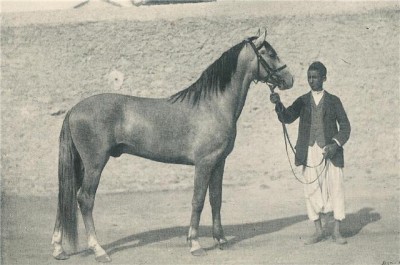Photo of the Day: Ben Chicao, desert-bred import to Algeria
Another desert-bred imported to Algeria in the XIXth century is Ben Chicao. I don’t know his strain or his breeder. He is represented in modern pedigrees through his daughter Addresse (x Pervenche), to whom the stallion Madani (Souci x Sissana by Mossoul) has a line in the middle of the pedigree. He was otherwise rarely used.
Is that a good Arabian horse conformation wise, judging from the photo? What do you think?

His hindquarters do not look ‘Arabian’ to my eye.
I agree with Tzviah that this horse does not look “Arabian” to me in this photo, but I have seen enough in the way of photos in my time to wish there was something of him as a mature stallion.
Thanks again Edouard, for posting this picture. Just another little piece of my mares’ pedigree. 🙂
Keep ’em coming!
Regards
Sandra 🙂
Does anyone know which color he is registered as in the French Stud Book? Isn’t it chestnut? If that’s the case, then this may not be him?
Allbreed shows him as a chestnut but in the studbook of the FNARC (see here: http://www.fnarc.nat.tn/default_an.php?k=info_gen_cheval_en.php&num_cheval=52001411 ) there is no color given.
Regards
Sandra 🙂
Hmmm. I am not comfortable making a determination of how much Arabian-like this horse is from this one photo. However, on closer inspection the root of his tail may be higher up than it appears, and while, as an individual, I find his barrel more wanting in round form and definition, he may be in racing condition, hence more drawn up. His head seems to me of balanced proportions with good fullness of jowl, eyes of good size, prominent and well placed, a graceful Mitbah accented by nicely shaped well set ears. With no “Marbat” it is a guessing game on his ancestry, but are there any clues to his origins?
Some of the most “asil” Arabians of the past are not much different from this picture in general, Astraled (Mesaoud x Queen of Sheba) being one example. Various photos of Astraled support the rounded slope in his hindquarters, as well as a head of considerable substance with a rather thick muzzle, plainer than Ben Chicao. Lady Anne Blunt had remarked on Astraled’s rather “imperfect profile” and Wilfrid Blunt called him a “little race-horse” alluding to perhaps a “Thoroughbred” like appearance. Nonetheless, with his prized ancestry they valued him for his style and quality. What set him apart was their description of his style in movement, seldom easily depicted in old photos. I am left to believe that he would be a far more impressive horse overall in person than any of his published photos. Fortunately he was not eliminated on looks, considering he was an excellent sire, often a source of superior movement, endurance, and for those that seek it out, the black-brown and dark colors. Of course he also had the “Marbat” and his legacy as a sire has been carried forward by horses like Gulastra, Rustem, Riyala, Sotamm, all showing his good points while passing on improvements along the way. His blood is well rooted in today’s Al Khamsa and Egyptian Arabians.
The head is small, distinctive and dry with a straight brow line and widely spaced, dark eyes. The jowls are wide and far apart horizontally, the nostrils large, flexible and expandable. The neck is elegant, long and curved upwards, has a slight throat and turns into a sloping shoulder. The withers are pronounced and has a good saddle area, the back is of medium length with a sufficient depth of chest. The body is well muscled, croup, the long and slightly tilted. The tail is set high and is elevated worn. Coat and top coat is fine and silky and emphasize the nobility of the race. The foundation is dry, to match the body and has the correct, large joints of medium-length chains and well-shaped hooves.
Many Desert Bred’s are lookes like him
This horse Ben Chicao, has one of the best couplings I’ve ever seen on an arabian horse. It is short, smooth, and therefor powerful. With it, he would well be able to flex his stomach muscles- and consequently tuck his pelvis- thereby lifting his back-and if the rider allows it arching his neck to completely go into the body posture known as true collection. His stifles appear to be angled outward sufficiently so that they will swing to the outside of his rib cage when he tracks up i.e. steps under his navel, a prerequisite for carrying the weight of himself and his rider equally with all four legs. The previous poster Teymour, is quite correct in his statement that many desertbreds look like him. This horse, and as Joe Ferris mentioned Astraled, are the kind of horses that got the arabian its reputation as an athletic horse. Probably that is why the U.S. Army remount used Astraled at stud for many years. In the opinion of many, tabletop croups were a western innovation that spread through the breed with the rise of halter classes and the southern california show system.
Best wishes
Bruce Peek